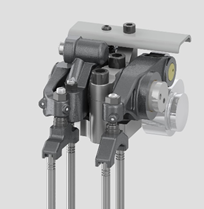Jacobs Debuts 1.5 HPD Stroke Engine Brake
Jacobs Vehicle Systems®, a leading manufacturer of heavy-duty diesel engine retarding systems, has launched 1.5 Stroke HPD, a new variation of the innovative High Power Density® (HPD®) engine brake that the company introduced on a demonstration truck in 2016.
This new HPD option provides heavy vehicles with significantly higher levels of supplemental braking force than traditional compression release braking, but with less complexity and cost than Two-Stroke HPD.
As with Two-Stroke HPD, 1.5 Stroke HPD provides small and medium displacement engines with large engine displacement retarding power. By adopting a different valve train and valve opening strategy than Two-Stroke HPD, 1.5 Stroke HPD has a more conservative technical strategy that will better suit the requirements of some engine hardware without compromising on performance.
“1.5 Stroke HPD is a new development resulting from Jacobs’ ongoing HPD prototyping programme. It follows the launch of Two-Stroke HPD, which was designed for a particularly complex engine design,” explains Steve Ernest, Vice President of Engineering & Business Development at Jacobs Vehicle Systems. “1.5 Stroke HPD is a simpler and more affordable route that will see our customers achieve the same step-change in braking performance as with Two-Stroke HPD, if their engine hardware allows for that.”
A conventional engine brake has one compression release and one brake gas recirculation (BGR) event for each of the engine’s cam rotations. With Two-Stroke HPD, cylinder deactivation mechanisms eliminate the main intake and exhaust valve events, allowing the intake and exhaust braking rockers to provide two intake, two CR and two BGR events per cam rotation. In 1.5 Stroke HPD, the exhaust event is deactivated; however, there is no deactivation of the main intake valve events and no additional intake lift events to support the second compression release. The normal intake is provided for the first CR, and gases used in the second compression release event are generated solely by the recirculation of exhaust manifold gases, without drawing air from the intake manifold.
With this simpler approach, 1.5 Stroke HPD nevertheless realizes braking power improvements of up to 40 percent at high engine speeds when compared with traditional compression release braking, and improvements of up to 100 percent at low engine speeds. The low rpm benefits are especially important because of the increasing numbers of engines with higher power density and lower operating speeds, characteristics shaped by the pursuit of better fuel economy and lower total cost of ownership.
Engine brake retarding performance has become increasingly important because key strategies for improving fuel efficiency are reducing the natural retarding of vehicles caused by aerodynamic drag, friction in the engine and drive train, and rolling resistance from the tires. Another effect of market demand for improved fuel economy is the conversion of some fleet vehicles to natural gas engines, whose smaller turbochargers and lower compression ratios can diminish engine brake retarding power by up to 25 percent. HPD compensates for this loss so that fleets can still haul standard load sizes safely.
Category: Breaks, Suspensions & Chassis, General Update, News











